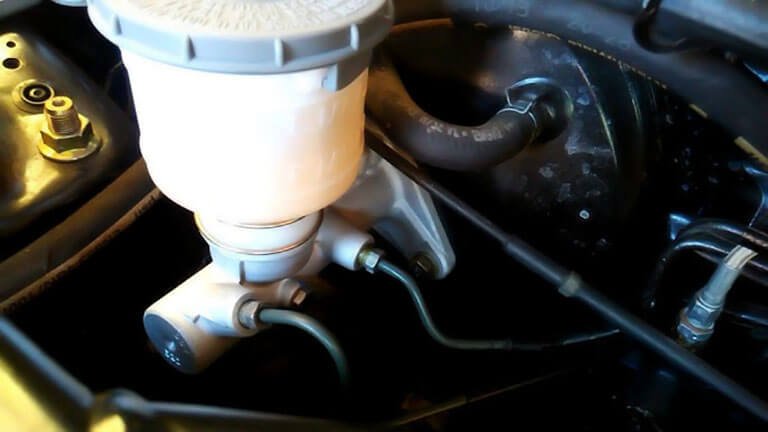Brake Master Cylinder Problems Symptoms: Quick Fixes!
Brake master cylinder problems can manifest as a spongy brake pedal or a sudden loss of brake fluid. Other symptoms include warning lights on the dashboard and uneven braking performance.
The brake master cylinder is crucial for vehicle safety, ensuring effective braking. A malfunctioning cylinder can lead to serious issues on the road. Drivers must recognize early signs of trouble to avoid dangerous situations. Common symptoms include a soft or sinking brake pedal, fluid leaks, and a dashboard warning light.
Addressing these issues quickly can save you time and money on repairs. Understanding the function of the brake master cylinder helps in identifying problems early, ensuring your vehicle remains safe and reliable. Regular maintenance checks can prevent unexpected failures and enhance driving confidence.
Introduction To Brake Master Cylinder Issues

The brake master cylinder plays a crucial role in your vehicle’s braking system. It converts your foot pressure into hydraulic pressure. This pressure activates the brakes at each wheel. Problems with the brake master cylinder can lead to serious safety issues. Recognizing the symptoms early can prevent accidents.
Significance In Vehicle Safety
The brake master cylinder is vital for safe driving. It ensures that your vehicle stops efficiently. Here are some key points about its significance:
- Immediate Response: It provides quick brake response.
- Brake Fluid Management: It maintains proper brake fluid levels.
- Even Pressure Distribution: It evenly distributes pressure to all brakes.
Without a functioning master cylinder, brakes may fail. This can lead to dangerous situations on the road.
Common Causes Of Failure
Several factors can lead to brake master cylinder failure. Understanding these can help you keep your vehicle safe. Here’s a list of common causes:
- Contaminated Brake Fluid: Dirt or moisture can damage the cylinder.
- Wear and Tear: Over time, seals can degrade.
- Corrosion: Rust can develop inside the cylinder.
- Poor Installation: Improperly installed parts can cause issues.
- Mechanical Failure: Internal components can fail unexpectedly.
Regular maintenance is key to avoiding these problems.
Identifying Symptoms Of A Faulty Brake Master Cylinder
A faulty brake master cylinder can lead to serious safety issues. Knowing the symptoms helps ensure your safety on the road. Below are key signs indicating a malfunctioning brake master cylinder.
Spongy Or Soft Brake Pedal
A spongy or soft brake pedal is a common symptom. Pressing the pedal feels less responsive than usual. This issue may indicate air in the brake lines or a failing master cylinder.
- Check for consistent resistance.
- Test the pedal while the engine is running.
- Listen for unusual sounds during braking.
Brake Fluid Leaks
Brake fluid leaks are a serious concern. Inspect your vehicle for visible leaks around the master cylinder. A low brake fluid level can lead to brake failure.
| Location | Leak Indicators |
|---|---|
| Under the Vehicle | Puddles of clear or brown fluid |
| Near the Master Cylinder | Wet spots or stains |
Irregular Brake Pedal Response
Notice any irregularities in brake pedal response. A pedal that sinks to the floor indicates a problem. This can happen due to internal leaks within the master cylinder.
- Test the brake pedal while stationary.
- Observe any changes in pressure during braking.
- Check for delayed braking action.
Warning Lights Activation
Warning lights on your dashboard signal issues. A brake warning light may appear for various reasons. This includes problems with the master cylinder.
Always pay attention to dashboard alerts. Ignoring these lights can lead to more severe damage.
Quick Fixes At Home
Brake master cylinder problems can be alarming. Fortunately, some quick fixes can be done at home. These methods can help restore your vehicle’s braking efficiency. Here are some simple steps to troubleshoot issues.
Checking And Refilling Brake Fluid
Low brake fluid often leads to brake problems. Checking the fluid is easy. Follow these steps:
- Locate the brake fluid reservoir. It is usually near the back of the engine bay.
- Check the fluid level. It should be between the “MIN” and “MAX” lines.
- If low, add the recommended brake fluid type.
Use only the type specified in your owner’s manual. Improper fluid can harm the brake system.
Bleeding The Brake System
Air in the brake lines can cause soft brakes. Bleeding the system removes trapped air. Here’s how:
- Gather tools: brake fluid, a wrench, and a helper.
- Start with the wheel farthest from the master cylinder.
- Loosen the bleeder valve slightly.
- Have your helper press the brake pedal.
- Tighten the valve before your helper releases the pedal.
- Repeat until fluid flows without bubbles.
This process ensures your brakes function well again.
Adjusting The Brake Pedal
Sometimes, the brake pedal height can be off. Adjusting it can improve your braking experience. Follow these steps:
- Locate the brake pedal adjustment rod.
- Loosen the lock nut.
- Turn the rod to adjust the pedal height.
- Tighten the lock nut once adjusted.
Ensure the pedal feels comfortable and responsive. Proper adjustment enhances safety.
When To Seek Professional Help
Brake issues can become serious quickly. Understanding when to seek professional help is crucial. Look for specific symptoms that indicate problems with the brake master cylinder.
Persistent Brake Performance Issues
Watch for these signs:
- Soft Brake Pedal: Pedal sinks to the floor.
- Unresponsive Brakes: Brakes feel weak or fail.
- Fluid Leaks: Noticeable fluid under the vehicle.
These symptoms often mean the master cylinder is failing. Don’t ignore them. Seeking help early prevents further damage.
Complex Brake System Diagnostics
Brakes are complex systems. Problems may not always be obvious. A professional can:
- Diagnose the master cylinder.
- Check for other brake issues.
- Test brake fluid quality.
Proper diagnostics ensure safe driving. Inexperienced attempts may worsen issues. Trust a professional for thorough checks.
Master Cylinder Replacement
Replacing the master cylinder is essential in some cases. Signs that replacement is needed include:
| Symptoms | Action |
|---|---|
| Severe brake fluid leaks | Replace immediately |
| Frequent brake pedal issues | Consult a mechanic |
| Dashboard warning lights | Seek professional evaluation |
Timely replacement enhances safety. Don’t risk your safety or others’. Always consult a mechanic for replacement.
Diy Vs. Professional Repair
Deciding between DIY and professional repair for a brake master cylinder issue can be tricky. Each option has its benefits and drawbacks. Understanding the differences helps in making an informed choice.
Cost Implications
Cost is a major factor in the decision-making process.
- DIY Repair:
- Parts cost: $50 – $150
- Tools: $20 – $100 (if not already owned)
- No labor charges
- Professional Repair:
- Parts cost: $50 – $150
- Labor cost: $100 – $300
DIY repair can save money but may require upfront tool costs. Professional repair ensures expertise but at a higher price.
Time Considerations
Time is another crucial aspect to consider.
| Repair Type | Estimated Time |
|---|---|
| DIY Repair | 3 – 5 hours |
| Professional Repair | 1 – 3 hours |
DIY repairs take longer due to learning and troubleshooting. Professionals often complete repairs faster due to experience.
Quality And Safety
Quality and safety are paramount in brake repairs.
- DIY Repair:
- Risk of improper installation.
- Quality depends on skill level.
- Professional Repair:
- Guaranteed expertise and experience.
- Access to quality parts and tools.
Choosing professional repair often ensures better safety and reliability.
Preventive Measures And Maintenance Tips
Maintaining your brake system is vital for safety. Regular checks can prevent serious issues. Understanding the components helps keep your vehicle safe. Here are some essential tips.
Regular Brake System Checks
Frequent inspections help spot problems early. Check these components regularly:
- Brake pads and rotors
- Brake lines and hoses
- Master cylinder condition
- Brake fluid level
Look for signs of wear or leaks. Listen for unusual noises while braking. Schedule professional inspections every six months.
Understanding Brake Fluid Types
Brake fluid plays a crucial role in brake function. Different types exist, and using the right one is key. Here’s a quick reference:
| Brake Fluid Type | Characteristics | Use Cases |
|---|---|---|
| DOT 3 | Standard, absorbs moisture | Most vehicles |
| DOT 4 | Higher boiling point | Performance cars |
| DOT 5 | Silicone-based, does not absorb moisture | Special applications |
Check your owner’s manual for the correct type. Replace fluid every two years to maintain performance.
Proper Driving Habits
Your driving style impacts brake health. Follow these habits for longer-lasting brakes:
- Brake gently and gradually.
- Avoid sudden stops.
- Maintain a safe distance from the car ahead.
- Use engine braking when possible.
These habits can reduce wear and tear. Safe driving extends your brake system’s life.
Navigating Warranty And Insurance Claims
Understanding your warranty and insurance can help with brake master cylinder issues. Knowing what is covered and how to file claims eases stress. Here’s a breakdown of essential steps to take.
What’s Typically Covered
Warranties often cover parts and labor. Here are common items covered:
- Brake master cylinder replacement
- Labor costs for installation
- Related brake system components
Check your warranty terms. Some may have exclusions. Look for:
- Wear and tear limitations
- Specific mileage limits
- Time constraints on claims
Filing A Claim
Filing a claim requires specific steps. Follow this simple guide:
- Gather necessary documents:
- Proof of warranty
- Repair invoices
- Photos of the problem
- Contact your warranty provider or insurance company.
- Complete any claim forms they require.
- Submit all documentation for review.
Keep copies of everything. This helps track your claim progress.
Dealing With Denials
Claims can sometimes be denied. Here’s how to handle it:
- Request a written explanation for the denial.
- Review warranty terms carefully.
- Gather more evidence to support your case:
- Additional photos
- Expert opinions from mechanics
- Previous service records
- Appeal the denial in writing.
Stay persistent and organized. Keep records of all communications.
Frequently Asked Questions
What Are Common Brake Master Cylinder Symptoms?
Common symptoms include a spongy brake pedal, fluid leaks, and warning lights on the dashboard.
How To Check Brake Master Cylinder Issues?
Inspect for fluid leaks, check pedal firmness, and monitor brake fluid levels for abnormalities.
Can A Bad Master Cylinder Cause Brake Failure?
Yes, a faulty master cylinder can lead to complete brake failure, posing serious safety risks.
What Causes Brake Master Cylinder Problems?
Causes include wear and tear, fluid contamination, and air trapped in the brake lines.
How Much Does It Cost To Replace A Master Cylinder?
Replacement costs typically range from $200 to $500, depending on the vehicle and labor rates.
Conclusion
Understanding brake master cylinder problems is crucial for safe driving. Recognizing symptoms early can prevent costly repairs and ensure your vehicle’s performance. Regular maintenance and timely inspections are key to avoiding issues. Stay vigilant for warning signs, and consult a professional if you notice any irregularities.
Your safety depends on it.






